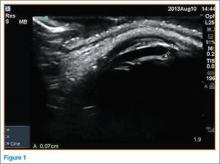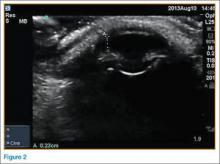Case
An 82-year-old woman presented to the ED for evaluation of left eye pain. She stated the pain began earlier in the day as a mild discomfort but progressed and acutely worsened 2 hours prior to presentation. She rated the pain as a “9” out of “10” on a pain scale; she described the pain as constant, with throbbing behind her left eye. There was no pain associated with extraocular movements. Photosensitivity and increased lacrimation of the left eye were present, along with associated nausea. The patient denied any ocular trauma or previous surgery.
On examination, the patient’s left pupil measured 4 mm, was oval in shape, and was nonreactive with surrounding scleral edema. Visual acuity on the right eye was 20/50, but on the left eye, she had only finger-counting at 2 feet. Since tonometry was unavailable, bedside ultrasound images of the affected eye (Figure 1) and a comparison image of the patient’s normal, unaffected eye (Figure 2) were taken, revealing acute angle closure glaucoma (AACG) in the patient’s left eye.
Ocular Ultrasound
To evaluate this patient, we used an ultrasound device that had the ideal 6- to 12-MHz linear probe for ocular evaluation. With the patient looking forward and eyes closed, the probe was placed in the transverse position over the midline. A generous portion of ultrasound gel was used to prevent additional pressure to the patient’s globe. When the cornea, iris, and lens were simultaneously visualized, the image was frozen to delineate the anterior chamber.1 Measurements were then taken perpendicularly from the cornea to the iris at the most shallow point and were compared to bilateral measurements. Normal anterior chambers range from 2 to 3 mm (with variation based on age, gender, and ethnicity).2 The patient’s affected eye had an anterior chamber depth of 0.7 mm (Figure 1) compared to 2.3 mm on her unaffected eye (Figure 2).Summary
Diagnosis of AACG in the ED is generally made through clinical examination and tonometry. Tonometry, however, may be either unavailable or malfunctioning. In such cases, bedside ultrasound can serve as an alternative diagnostic tool. Ocular ultrasound is also beneficial in diagnosing AACG in patients who do not present with classic signs and symptoms of the condition. The abnormal bedside ultrasound can prompt earlier specialist consultation, which may decrease negative long-term sequelae.
Dr Rose is ultrasound fellow and clinical instructor in the department of emergency medicine, University of Kentucky, Lexington. Dr Cuevas is a resident in the department of emergency medicine, University of Kentucky, Lexington. Dr Dawson is an associate professor, director of ultrasound fellowship, and director of point-of-care ultrasound in the department of emergency medicine, University of Kentucky, Lexington.


